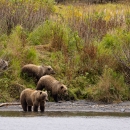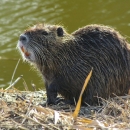Habitat restoration, Invasive species management
Invasive Plant Management
Status
Ongoing
States
AlaskaInvasive species threaten wild habitat and can have disastrous impacts on native plant and wildlife species. The Refuge surveys infestations, works with adjacent landowners, and uses integrated pest-management practices for early detection, prevention, and management of invasive weed problems. For several years, Refuge staff have worked to control a known infestation of orange hawkweed in the Camp Island area of Karluk Lake.




